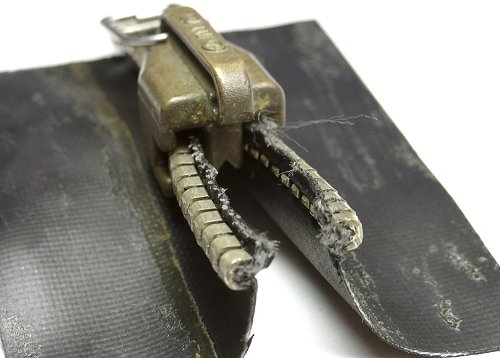Exposure Suits - Drysuits

Serious New Jersey divers wear drysuits. A drysuit is a waterproof suit with built-in feet that seals around your neck and wrists ( some have built-in water-tight gloves and/or hoods as well, ) and a waterproof zipper to close it up. The idea is that although you are underwater, you don't get wet, but this is not entirely true. No seal is perfect, and certain actions will let small amounts of water leak in past the seals. However, most of the moisture that accumulates in a drysuit comes from its occupant, in the form of perspiration. If water can't get in, then it can't get out either. Perhaps these should be called dampsuits instead of drysuits.
Still, in cold water, a drysuit is much warmer than a wetsuit. This is because you maintain a constant layer of air between you and the cold, and air is an excellent insulator. While air is also the insulating factor in wetsuits, there is a difference. With either suit, the volume of air, and therefore the amount of insulation, compresses as you go deeper. With a wetsuit, there is nothing you can do about this, but with a drysuit, simply tap the inlet valve, and compressed air will flow from your tank into the suit, and puff it up again, keeping you warm. An added benefit is that by keeping the suit inflated to a constant volume, you maintain constant buoyancy, from the surface to the bottom, which can actually reduce the amount of lead you need to carry. Some divers even dispense with the BCD, considering that a drysuit can be thought of as a full-body BCD, but this is not recommended, and it is convenient to use the BCD as a quick trimming device and for surface flotation.
Learning to use a drysuit is less difficult than you might think. You must hook up an extra hose from your regulator to the drysuit inflator. This hose should be routed around your right side, the same as your regulators. As you descend, you will need to add air to the suit. The suit will "squeeze" you uncomfortably if you fail to do this. You will have to relearn buoyancy skills in the water with the extra air volume of the suit, but this is not difficult. Finally, you must vent off the excess air from the suit as you ascend. I will not go into any of the potentially disastrous but easily avoided mishaps that can occur while using a drysuit. Taking an inexpensive drysuit specialty course or at least practicing with an experienced friend is strongly recommended.
A drysuit should fit well, but need not fit as precisely as a wetsuit. This can be a real boon to those who do not fit the 'average' body mold. Neck and wrist seals are made of either thin latex or thicker neoprene. After using all types, my preferences are for a fold-under neoprene neck seal and heavy-duty latex wrist seals. A neoprene neck seal will likely leak a few drops on every dive, but no more, and is quick and easy to put on. Latex neck seals require much fussing with to get them to lie right, and then they leak anyway. The neoprene neck seal is also warmer and lasts longer. Heavyweight latex wrist seals are far better than the standard fragile thin ones: longer-lasting and easier to get on and off.
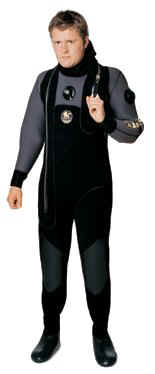
Drysuits come in several different designs, with varying features. The least expensive drysuits are made of the same thick neoprene material as wetsuits. All of the problems of variable buoyancy, loss of insulating value, and limited life that I described above with wetsuits carry over to these drysuits. Their big advantage is cost; some of these can be had on sale for nearly the same price as a top-end wetsuit. Another advantage is that these suits are pretty tough, owing to the thickness of the material, and easy to repair. Some people prefer the built-in insulation that these suits provide, which can be augmented optionally with undergarments.
A lot of the old-timers and commercial divers that I know use these suits and swear by them. An instance when this type of suit may be preferable is if you do long shallow decompression hangs. At shallow stop depths, the neoprene in the suit will puff up again, giving you some added insulation when you need it during long periods of inactivity. An old neoprene drysuit will eventually begin to leak as the gas bubbles in the material rupture into each other and eventually create passages for water to penetrate the suit. There is no good way to repair this, so a used neoprene drysuit is probably not a good buy.
Next up the ladder in drysuit technology is thin fabric drysuits. The best of these are made of three-layered sandwich material, called trilaminate, while cheaper ones are made of less durable two-layer material, and some industrial suits are made of a single layer of slick rubber, mainly so that they can be easily cleaned after use in toxic environments. All of these suits have several things in common. None has any insulating value of its own; for warmth you must wear undergarments. None is particularly abrasion-resistant, although trilaminate suits are not exactly delicate either, and some of the newest ones look very tough indeed, with ballistic nylon outers. Finally, none has any appreciable stretch to the material, which means the suit must be cut rather baggy to allow for movement. Fabric suits are very light and pack up very small, making them good for traveling. They are also more expensive than neoprene suits, and to this, you must add the cost of any undergarments.
The best drysuits are made of materials such as crushed or high-density neoprene. This material is extremely long-lived, tough and abrasion-resistant, and also stretchy, allowing the suit to be cut much finer than a "bag-suit". Although the material is thin ( about 3mm, ) it is also very dense, and these suits are nearly as heavy and bulky as ordinary neoprene suits, especially when wet, so they are not really suited to traveling. They also have practically no insulating value of their own and must be used with undergarments. These drysuits are also shockingly expensive, to which you must add the cost of any undergarments. Since the gas in crushed neoprene has already been squeezed from the material, such suits are not prone to inevitable leakage like ordinary neoprene suits. I own two old crushed neoprene suits, but given the tremendous improvements in trilaminate materials, I don't think crushed neoprene is worth the extra cost anymore.

Different drysuit manufacturers place the zipper in different locations. The most common and lowest-cost ( shortest ) zipper location is across the back of the shoulders. This obviously requires some assistance from a buddy to get in and out of the suit. Some suits use a variation where the zipper runs around the back of the neck and down the front. Others use a zipper across the front of the shoulders or around the waist, and you may still see an old suit now and then with a crotch zipper ( Try to figure out how that is supposed to work. ) the most expensive ( longest ) but best zipper placement is diagonally across the front, from the right hip up to the back of the left shoulder, making the suit "self-donning" if you are limber enough. While zipper placement is really a matter of choice, valve placement is not. The inflator valve should be in the center of the chest, and the exhaust valve should be high on the left arm. Avoid other valve placements and gimmicks such as mini-exhaust valves at the ankles and wrists - there is definitely only one right way about this.
Drysuit undergarments can be anything you want, from sweats and long johns to expensive purpose-made jumpsuits. The best material is water-shedding polyester fleece, the worst is highly absorbent cotton. A layering approach is usually best, depending on how cold the water is. Jumpsuit-style undergarments ( as shown ) with knit cuffs and a nylon outer shell are both windproof and waterproof, which will keep the inevitable small leaks and condensation off you, and also keep you warmer on cold days when you are out of your suit. Add extra layers underneath as necessary. Polyester or wool socks complete the outfit.
Of the high-tech insulating materials available today, Polartec fleece ( polyester micro-fiber ) is much better for diving than Thinsulate. Polartec material retains more of its insulating value when wet, and is also longer-lasting and easier to launder than Thinsulate, which quickly pills-up and becomes worthless. Highly suitable and reasonably priced Polartec undergarments can often be found in the skiing section of your local sporting goods store over the winter. Just remember, with any of these high-tech plastic materials - one trip through the clothes dryer and you can throw it away.

way to Dutch Springs.
I'm trying to keep this all objective, but I have observed that there seem to be two kinds of drysuit divers: those that have DUI's, and those that wish they did. DUI is arguably the Cadillac of drysuits, and certainly the most expensive. A crushed neoprene DUI drysuit can be expected to last a lifetime, with necessary maintenance. For those on a tighter budget, a good quality trilaminate suit and some long underwear from K-Mart will keep you pretty warm for a lot less money, and if you can afford this level of investment, then I think you should skip the wetsuit and go straight to dry. I wouldn't recommend heavy neoprene drysuits for beginners, even though they are the most affordable. And no RockBoots.
A final accessory for drysuit diving is ankle weights - small lead anklets that help you maintain your equilibrium with the drysuit on. I would also recommend some sort of weight-integrated BC system for use with a drysuit, although I see a lot of folks do fine with just a plain old weight belt.
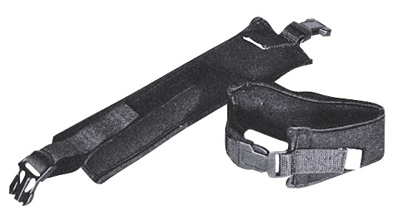
In a typical drysuit course, you will learn how to do emergency air dumps by pulling open wrist or neck seals. This "skill" works fine in a warm pool with bare head and hands, but how are you supposed to do it in the real world with long gloves and hood on? Much scuba training is not as well-thought-out as it seems.
Suit Maintenance
Drysuits are much longer-lasting than wetsuits, but they also have higher maintenance costs, as seals and zippers wear out over time. Some ballpark drysuit maintenance figures:
| item - local rates, rush job ( when is it not ? ) |
cost | life expectancy | |
| replace neck seal | latex | $100 | 1-3 years (100 dives) |
| neoprene | $200 | 3-5 years | |
| replace wrist seals | latex, pair | $75 | 1-2 years (100 dives) |
| neoprene, pair | $150 | 3-5 years | |
| replace zipper | self-donning type | $300 | 2-3 years (150 dives) |
| replace inlet valve | $100 | when necessary | |
| replace exhaust valve | $150 | when necessary | |
| service inlet & exhaust valves | $50 | when necessary | |
| repair minor leaks & test | $50 | when necessary | |
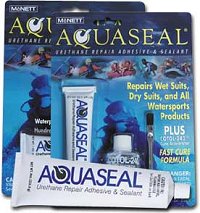
Small leaks and tears are easily repaired at home using AquaSeal. Rips and tears in foam neoprene are easily repaired with neoprene cement, and then waterproofed with AquaSeal. Valves and other hardware may be affixed to flexible suit material with RTV silicone. Repairs should be made to the inside of the suit, where they will not show. To mark the location of a small leak, push a pin through it ( no harm - it leaks already! ) then apply sealant to the inside, and pull the pin out.

Old leaky AquaSeal is easily removed using a Dremel tool with a sanding barrel. Keep the tool moving to avoid overheating the material, and be careful not to cut into the soft suit material underneath. AquaSeal works much better with Cotol thinner and accelerant. "Cotol" is nothing more than toluene ( right, aka methylbenzene ) - a common paint stripper and thinner, that is also used as an octane-increasing fuel additive. Toluene is available by the gallon ( about $7 ) at any better hardware or paint store, or by the half-ounce ( also about $7 ) at the dive shop. AquaSeal is generally available in the fishing/boating section of Sports Authority for $4.99 / ounce. Toluene is an excellent thinner for all sorts of other adhesives as well.
As you can see, the averaged cost of maintaining a drysuit is roughly equal to buying a new wetsuit every year! The real difference is in the quality of cold water exposure protection - there is no comparison. If you plan to dive a lot in cold water, the extra expense of a drysuit is well worth it.
Rock Boots
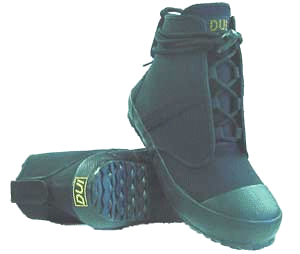
Although DUI in many ways sets the standard for drysuit design, they are not perfect. One of their latest innovations is the "RockBoot" - a sneaker-like nylon shoe that fits over the foot of the suit, which is reduced to a sole-less waterproof sock.
- RockBoots are one more thing to pack, one more thing to put on, one more thing to take off, and one more thing to wear-out or lose or forget.
- They are left and right. Left and right fins were banished from diving long ago. Why be bothered ?
- They are bulky and stiff, requiring oversized fins which are often simply not available. Your existing fins will almost certainly not fit and will have to be replaced.
- Yet they are also close-fitting, and limit your options for insulation in cold water.
- Yet they are not particularly comfortable.
- They don't even close up with Velcro like a decent pair of sneakers, but have bothersome laces. Try that with cold-numbed fingers.
"RockBoots" are totally unnecessary for boat dives, where you merely have to stagger a few feet to the side of the boat and fall overboard, then climb back up the ladder in your fins. "RockBoots" are actually bad for beach diving, where the sand will inevitably work its way inside the boot and abrade away the foot of the drysuit until it leaks. I don't go hiking in a drysuit, and I will not wear hiking boots while I am diving !
Maybe in some parts of California, where the shoreline really is rocky, these things are somewhat useful. In the rest of the world, "RockBoots" make absolutely no sense, and nobody I have ever spoken to about the "RockBoots" on their DUI suit has ever had anything good to say about them. Luckily, you can still get the old-style Vibram-sole drysuit boots as a special-order item, although ironically DUI now charges extra for them.
If you are unfortunate enough to already have a suit with "Rock Boots", one thing you can do is get an inexpensive set of wetsuit booties and use them instead!
Rant Against DUI

In my opinion, DUI perfected the drysuit around 1990 and has been screwing it up ever since. They seem determined to glue everything but the kitchen sink onto their suits - huge kangaroo pockets, useless (dangerous) knife-holders, "warm-neck" collars that just don't work, colored overlays that add nothing but weight and bulk, with unnecessary zippers that trap sand and grit, complicated failure-prone seals and dry-gloves, and finally, the afore-mentioned hated Rock Boots.
Of course, these are all things they can charge extra for, and this seems to have been used as justification to raise their prices into the stratosphere - pushing $3000. Even so, some of the components are just plain cheap, like the narrow black suspenders that are so prone to end up in your crotch instead of over your shoulders. How much would it cost to make them right - wide and yellow, with quick releases so you can untangle them without taking the suit off. Also, the fit of even their "custom" suits is questionable, and I detest the ridiculously narrow ankles that make getting the suit on and off unnecessarily difficult, especially with several pairs of socks in the wintertime. DUI seems to design their suits for San Diego as if no other place existed on earth.
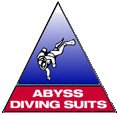

You can now get two good suits from other manufacturers for the price of a single "loaded" DUI. My old DUI finally wore out, and I now use a Bare. In particular, take a look at new products from Abyss and Diving Concepts. The compressed neoprene suits look especially nice.

